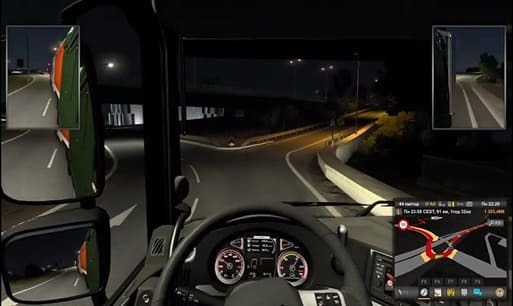Development of virtual simulator for learning to drive a car
Content
- Introduction
- 1. Methods of teaching car driving
- 2. Overview of virtual simulators
- 3. Advantages of car simulators and simulators
- 4. Description of the architecture and functionality of the virtual simulator
- Conclusions
- List of sources
Introduction
With the development of computer technology, in particular graphics and virtual reality, new forms of learning have become possible, including learning in virtual space. Virtual simulators allow students to gain practical skills without risk to themselves and others. Unlike traditional methods of driving instruction, where students are trained on the road, virtual simulators provide safer and more cost-effective training.
Moreover, virtual simulators can help students learn not only the basics of driving a car, but also additional skills such as driving in difficult weather conditions, driving in extreme situations, and others. This allows students to gain a more complete understanding of how to drive a car in different conditions and on different roads.
Virtual simulators can also be used to train people who, due to physical limitations, cannot obtain a driving license. In such cases, virtual simulators allow you to simulate the process of driving a car and gain the necessary skills without having to be on the road.
The purpose of this study is to develop a virtual simulator for learning how to drive a car, which would have high efficiency and could compete with traditional teaching methods.
To achieve this goal, the following tasks were formulated:
- To review existing virtual driving simulators and identify their advantages and disadvantages.
- Choose the most appropriate technology for creating a virtual simulator, taking into account the requirements for realism and effectiveness of training.
- To identify the advantages and disadvantages of the virtual simulator and determine its prospects for use in educational institutions and driving schools
1. Methods of teaching car driving
There are several methods of learning to drive a car, each of which has its advantages and disadvantages. The traditional approach involves an instructor and a training car, and is the most common way of learning how to drive a car. However, it has a number of limitations, such as the limited time of the instructor, the need to be on the road, the influence of environmental factors, etc.[1]
Driving a car in modern conditions is an extremely difficult process in technical and psychological terms. The amount of information that falls on a novice driver significantly exceeds the possibilities of its assimilation. In order to move along the road even with minimal intensity, the driver must perform many actions in strict sequence and with precise dosage. Each of them requires a certain skill and is very complex, consisting of several movements.
The analysis of human activity at the wheel allows us to outline three stages that he must go through sequentially as he improves his driving skills. Moreover, each previous stage is necessary to achieve the next one.[2]
At stage 1, the driver must achieve a certain technical skill. Technical skill refers to the degree of training of drivers in performing all actions related to controlling the mechanisms of the car. This includes control of the engine, clutch, gearbox, brakes, steering wheel. The training of all these actions, previously divided into separate movements, should be carried out sequentially in stationary conditions using simulators. This stage, like any initial stage of training, is of fundamental importance for the further formation of the driver. Therefore, the task of the teacher is not only to take this work seriously himself, but also to inspire the student with the extreme fundamental importance of this stage.
At the 2nd stage of training, it is important that the trainee learns to drive along a given trajectory not only the front, but also the rear wheels of the car. So, after the first two stages of training, the trainee must actually fully master the technical side of driving a car. Any actions with levers and pedals should not cause him difficulties, he must also choose and perform the intended actions correctly on a car moving on a closed area. In other words, the trainee must professionally drive a car on a closed area or on a deserted road in the complete absence of other road users. After reaching this level, you can proceed to the third, final stage of driver training.
The task of the 3rd stage is to instill skills of interaction with other traffic participants, forecasting road situations, preventing emergency situations, choosing the optimal row and place in the flow, driving dangerous sections (intersections, public transport stops, pedestrian crossings, etc.). At the 3rd stage, it is necessary to develop skills to get out of some emergency situations situations (for example, clearing an incipient drift).
The result of driver training with the sequential passage of three stages should be the fluency of a car in various DTS, and only after that a graduate of a driving school can be recognized as a driver and receive an appropriate certificate. When choosing a particular maneuver in difficult situations, a graduate of a driving school should proceed only from tactical considerations, and the technical difficulties of performing this maneuver should not stop him.[3]
He must be able to do everything: start on the rise, and drive in a limited space, and drive fast, turn and turn around at a busy intersection, and overtake or bypass a vehicle. It should not be difficult for him to move at night, on a slippery road, etc.
2. Overview of virtual simulators
To date, there are many virtual simulators for learning how to drive a car.[4] Let's look at some of the most popular simulators and their features.
Gran Turismo Sport is a racing simulator that offers various tracks and cars for players. It provides realistic driving conditions at high speed, and also allows you to customize the car to improve its performance (see Figure 1). However, the disadvantage of this simulator is the lack of training modes, which makes it unsuitable for beginners in learning how to drive a car.

Figure 1 – The level of realism of the Gran Turismo Sport graphics
City Car Driving is a virtual simulator that simulates driving on city streets. It provides training modes that help players improve their driving skills, such as parking and U-turn on a narrow road. However, the disadvantage of this simulator is the limited number of cars and tracks.
Assetto Corsa is a racing track simulator that has an excellent physical model of the car. It allows players to customize the car to improve its performance and provides many settings to optimize the graphics. The disadvantage is that it does not have training modes, which makes it unsuitable for beginners in learning how to drive a car.
Euro Truck Simulator 2 is a virtual simulator that simulates truck driving. Figure 2 shows a training mode that helps players improve their driving skills, such as turning at an intersection and driving a truck with a trailer. The disadvantage is that it does not train drivers of passenger cars, as well as the lack of a variety of trails and cars.

Figure 2 – Training the user to turn
Existing virtual driving simulators have their advantages and disadvantages, and each of them can be useful for teaching certain driving skills. However, none of the simulators considered is ideal for learning how to drive a car in general.[5]
Therefore, the goal of our work is to create a new virtual simulator that will combine the advantages of all existing simulators and will effectively teach driving skills from basic to advanced.
3. Advantages of car simulators and simulators
For experienced drivers, the car driving simulator is nothing more than just a game. The conditions on real roads are completely different. It is unlikely that an experienced motorist will learn something new in this application, nor will he lose the skills he has gained over the years if he manages a virtual machine. The situation is completely different with novice drivers. Car driving simulators will be able to help novice motorists learn how to drive a car. Namely: to understand how to read road signs, as well as to learn them, to understand the sequence of actions at the beginning of movement and braking, to understand how to react in different situations, to navigate by mirrors.
Drivers who have just got behind the wheel can get a lot of benefits from car driving simulators. For example, motorists will be able to hone the following skills:
- navigate the traffic flow;
- hone your car control skills: change lanes, cross unregulated intersections, park, etc.;
- react quickly to different situations on the road;
- navigate correctly by mirrors.[6]
Instructors often face a problem while studying at a driving school. When leaving for the city, some cadets simply get lost and do not know how to behave. Some fall into a stupor, others forget to slow down or start in time. However, future drivers who periodically practice driving a car simulator feel more confident behind the wheel.
There is also some harm in this game, which, first of all, is inflicted on already experienced drivers. We are talking about the following nuances:
- Limited realism: Some aspects of the virtual simulator may be less realistic than in real life, which may lead to a mismatch between the skills acquired in the virtual world and the real conditions on the road.
- The driver stops realizing the danger. Especially for avid players, the sense of responsibility and reality is dulled. After all, everything is simple in the game. I got into an accident – I started over, the car recovered, my health too. In real life, alas, everything is much different.
- Limited availability: Some people may not have access to the computers or software needed to use virtual simulators.
- Speeding. After the virtual world on real roads, motorists begin to feel that they are driving too slowly, as a result – a significant excess of the speed limit.
- Limited interpersonal contact: Virtual simulators cannot offer the same level of interpersonal contact and interaction with the instructor, which may be useful for some people in the learning process.[7]
The lack of real experience can prevent a person from really preparing for an extreme event when they find themselves on the road. This does not mean that driving simulators have no place in driver training courses. They just have to be one of the tools of the training process for future drivers. As technology continues to evolve, the old methods of driving schools are still the most realistic and allow you to teach all the subtleties of driving.
4. Description of the architecture and functionality of the virtual simulator
The development of a virtual simulator for learning to drive a car is a complex and promising process aimed at improving the methods of learning to drive in virtual reality.
Simulator architecture
Architecturally, the virtual simulator will include highly detailed 3D models of cars and the environment, creating an educational space as close as possible to the real road environment. This includes aspects of movement, control, braking, and interaction with the environment. Detailed 3D models of cars and the environment provide visual realism, creating an educational space identical to real road conditions. The physical model of the car will be extremely accurate, providing a realistic reproduction of all aspects of driving a vehicle. The system of visual and sound effects enhances the realism of the simulator. This includes dynamic lighting changes, realistic engine and environmental sounds, as well as weather effects such as rain, snow and fog.[8]
The virtual simulator will also have a multi-level training system, including basic driving elements such as steering and braking, and progressing to more complex scenarios, including driving in various weather conditions and in difficult road situations.
Learning functionality
The simulator's functionality will be focused on interactivity and feedback, giving students the opportunity not only to test their skills, but also to receive constructive recommendations for their improvement. The performance monitoring system will monitor the student's development by creating personalized learning plans (see Figure 3).

Figure 3 – Diagram of functional requirements for simulation
The simulator includes a variety of training scenarios, ranging from basic driving skills to difficult situations on the road. The training takes place in real time, providing feedback and recommendations to improve driving skills.
The feedback system analyzes the student's performance, highlighting successful moments and identifying areas for improvement. Personalized reports provide students with insights into their progress and identify additional areas to focus on.
The simulator covers a variety of road scenarios, including different types of roads, traffic density, intersections and difficult road conditions. This provides students with driving experience in various situations and develops confidence in driving.
Selection of technologies and development tools
Justification of the choice of technologies and development tools for creating a virtual simulator for learning to drive a car is important to ensure the effectiveness, realism and convenience of the user experience.
In order to achieve the most realistic reproduction of car movement and the environment, it was decided to use advanced physics engines and graphics engines. This includes the Unity3D or Unreal Engine, which provide a high degree of detail to the visual and physical aspects of the simulator.
The integration of virtual reality technologies allows you to create a more immersive learning experience, enhancing the student's perception of reality. Oculus Rift, HTC Vive or other VR headsets will be supported for maximum engagement.
Modern controls such as motion sensors and controllers (steering wheel, gas pedals, brakes and clutches, etc.) are used to ensure intuitive operation and interactivity of the virtual car.
Cloud technologies have been selected to provide easy access and updates to the simulator. This will provide educational institutions and students with the latest versions of the simulator without the need for complex installations.
The choice of these technologies and tools is based on the desire to provide high-quality and modern driving training in a virtual environment. This set of technologies creates a balance between realism, accessibility and learning effectiveness, which is key to ensuring the successful development and use of a virtual simulator.
Conclusions
The master's thesis is devoted to the development of a virtual simulator for learning how to drive a car. As a result of this study, existing virtual simulators for learning to drive a car were analyzed and their advantages and disadvantages were identified. This analysis allowed us to identify areas for improving learning technologies and methods.
This study opens up new perspectives in the field of driving education and can be useful for a wide range of users, ranging from novice drivers to professionals who want to improve their driving skills. The development and improvement of virtual driving simulators will help improve road safety and reduce the number of accidents, which is one of the main tasks in the field of road safety.
In conclusion, it can be noted that the development of a virtual simulator for learning to drive a car is a promising area that can offer new opportunities in learning to drive a car. Virtual simulations can be useful not only for novice drivers, but also for those who want to improve their driving skills and safety on the road.
In addition, research in this area should be continued, technologies and teaching methods should be improved in order to create more realistic and effective virtual simulators for learning how to drive a car. This can help reduce the number of accidents on the roads and improve road safety in general.
List of sources
- Kadeeva, O.E., Dontsova, A.A. "Digitalization of modern education // Questions of pedagogy / O.E.Kadeeva, A.A.Dontsova, 2022. – 134 p.
- The methodology of teaching car driving [Electronic resource]. – Access mode: https://studopedia.su/14_43630_metodika-obucheniya-vozhdeniyu-avtomobilya.html
- Knebon, K. "Simulation in surgical training: Educational and practical aspects. Medical education.» / K. Knebon, 2003. - 10-12 p.
- Reigeluth, K., Schwartz, E. "Theory of learning for the development of computer simulators." / K. Reigelut, E.Schwartz, 1989. - 13-16 p.
- Burnyasheva, L.A. "Active and interactive teaching methods in the educational process of higher education: a methodological guide" / L.A. Burnyasheva, 2016. – 153-155 p.
- Car Driving Simulator: benefit or harm? [electronic resource]. – Access mode: https://àâòîøêîëà34.ðô/2020/02/27/simulyator-vozhdeniya-avtomobilya/
- Learning to drive using a simulator [Electronic resource]. – Access mode: https://caridea.ru/bezopasnoe-vozhdenie/obuchenie-vozhdeniju-pri-pomoschi-simuljatora
- Erbach, R. "Development and evaluation of a driving simulator in virtual reality" / R. Erbach, 2015. – 495 p.
